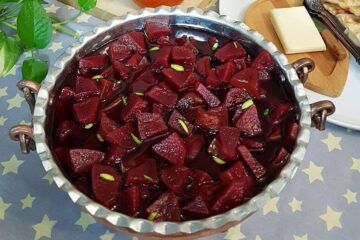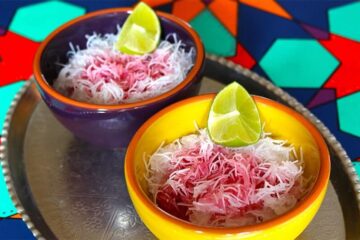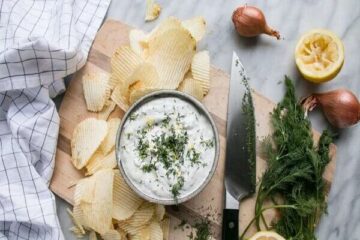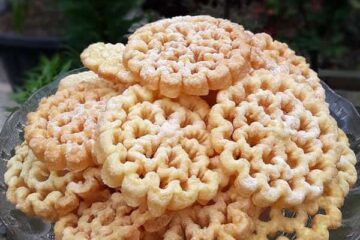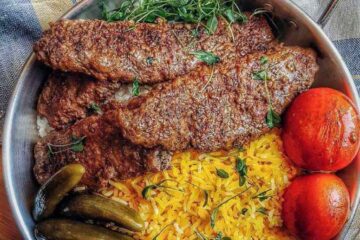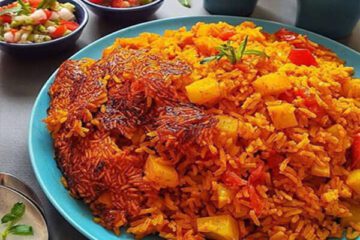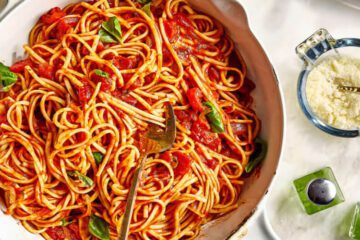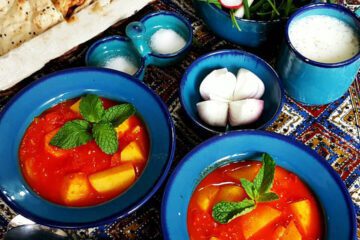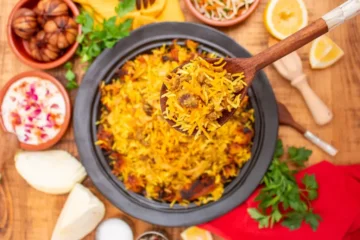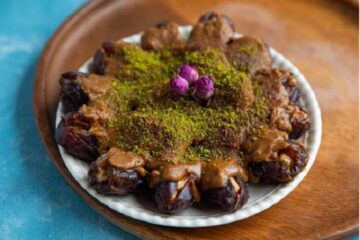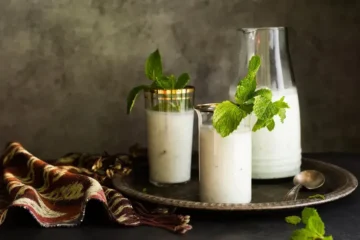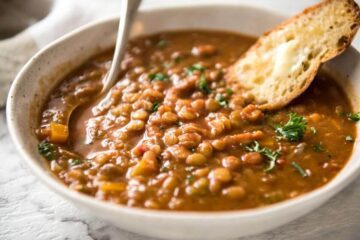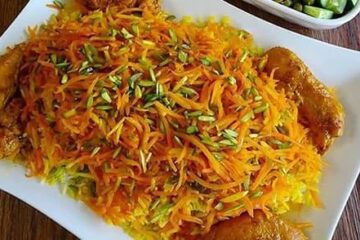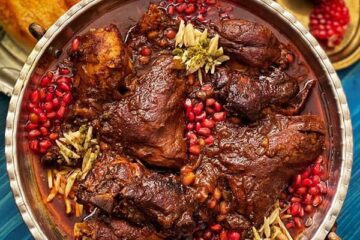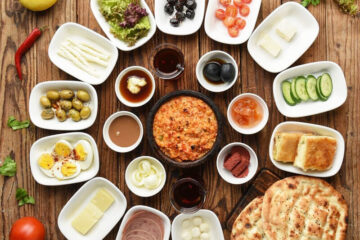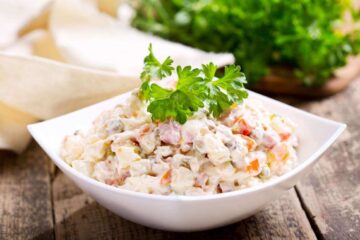Make Moraba Beh (Persian quince jam), one of the most famous Persian jams with excellent taste, in 8 steps.
Persian food
Persian Faloodeh Recipe
Faloodeh is an ancient Persian dessert made from rice noodles, sugar, and rose water. Follow this recipe to make Faloodeh for yourself.
Persian Fava Beans (Broad Beans) Recipe | Baghali Pokhteh
cooked fava beans, also called broad beans is one of the most popular snacks that is creamy and delicious with salt, vinegar, and golpar.
The 6 Best Persian Pickles (Torshi); Get to Know Different Iranian Pickles
Learn more about Persian pickles, made with various vegetables and vinegar that play a significant role in Middle Eastern cuisine.
Sosis Bandari Recipe; Persian Sausage and Onion
Learn how to make Sosis Bandari (Persian sausage and onion), one of the Iranian sandwich dishes made with sausage, onion, tomato paste, and some other spices.
How To Make Persian Homemade Barbari Bread?
Barbari bread is one of several types of yeast-risen Persian flatbread with a nice crust and soft inside. Do not miss Nan-e Barbari.
Shirini Keshmeshi Recipe; Make Nan Keshmeshi In Some Simple Steps
Learn how to make Shirini Keshmeshi, a delicious Persian cookie made with flour, sugar, raisins, and sometimes walnut, by following some simple steps!
Khoresht Kadoo Recipe, Persian Zucchini Stew
Khoresht kadoo, or zucchini stew, is an appetizing Persian food full of nutrition for the body. In this post, we cook this stew with chicken,
Mast O Musir Recipe | Persian Shallot And Yogurt Dip
Mast o musir is an incredibly delicious shallot and yogurt dip made with Persian shallots. It is commonly served as a side dish.
Nan Panjereh Recipe; Make Persian Rosettes in 8 Steps
Learn how to make Nan Panjereh, also known as Persian rosettes, a traditional Persian cookie that is crisp and light in 8 steps.
kabab Tabei Recipe, Persian Pan Kebab
Kabab Tabei is a Persian pan kebab that is quick and easy to cook in the house without a grill. Do not miss this delicious kebab.
Dami Gojeh Farangi Recipe; Make Delicious Persian Tomato Rice
Learn how to make Dami Gojeh Farangi, a popular Iranian pilaf dish made with onions, tomatoes, tomato paste, and rice.
Makaroni Recipe, Persian Spaghetti With Meat Sauce
Makaroni or the Persian spaghetti is one of the most popular foods in Iran. Follow this recipe to cook spaghetti based on an Iranian method.
Eshkeneh Recipe; Persian Onion Soup With Fenugreek and Egg
Eshkeneh is a classic but easy soup that you can cook it in 30 minutes. Ingredients of this onion soup can be found easily in every house.
Kalam polo recipe, the Persian cabbage rice
Kalam polo is a traditional Persian food with nutritious ingredients. This reach dish is originally from Shiraz, a beautiful city in Iran. Follow this recipe to cook kalam polo with ground meat.
Ranginak (Persian Date Walnut Dessert)
This fabulous date walnuts dessert is so easy to make and delicious. Ranginak’s ingredients are date, walnut, flour, cinnamon, and cardamom.
Doogh drink recipe, a Persian yogurt beverage
Doogh is a traditional Persian yogurt drink, highly popular in Iran. This refreshing beverage is a little bit salty, somehow fizzy, and usually flavored with herbs such as mint. Follow this post to learn more about doogh.
Meygoo Polo Recipe; Make Persian Prawn Rice in 7 Steps
Learn how to make Meygoo polo (Persian prawn rice), a popular iranian seafood in 7 simple steps.
Adasi Recipe; Make Delicious Persian Lentil Soup
Learn how to make Adasi, an original Iranian dish that is cooked in almost all parts of the country which is very nutritious and simple.
Shirin Polo Recipe; How to Make Persian Shirin Polo?
Learn how to male Shirin Polo, a Persian rice dish made with rice and a mixture of fruits, vegetables and nuts in some simple steps.
Khoresh Bamieh Recipe; Make Delicious Persian Okra Stew
Learn how to make khoresh bamieh (okra stew,) a famous Persian stew which is made with okra, meat, tomato, garlic and variety of spices in 9 steps.
Khoresh Morgh Nardoni Recipe; Persian Pomegranate Chicken
Make delicious khoresh morgh nardoni, an Iranian dish mostly made in autumn and winter, in a few simple steps.
The 16 Best Persian Breakfasts; How to Make Them at Home?
In this blog post, read about 16 hot and cold Persian Breakfasts, which are nutritious and healthy. Learn how to make them quickly at home.
Kale Pache Recipe; 11 Steps of Making Sheep Head
Kale Pache is a very delicious Persian dish that is usually served as breakfast. It needs a long time to cook over a gentle heat mixed with onion, peas, and spices.
Chenjeh kebab Recipe; 7 Simple Steps for Making Chenjeh Kabab
Learn how to make Chenjeh, a delicious classic Persian style mutton kebab with an onion, lemon, and olive oil marinade. , in 7 steps.
Salad Olivieh Recipe; Make Delicious Persian Chicken Salad
Learn how to make Salad olivieh (Persian potato and Chicken Salad), a famous Russian dish, in 9 simple steps.
Haleem Recipe; Delicious Persian Wheat and Meat Porridge
Learn how to make Haleem, a delicious porridge that gets ready with 2 main ingredients, meat, and wheat, in 6 simple steps.
Albaloo Polo Recipe; Delicious Cherry Rice Pilaf
Learn how to make Albaloo polo (sour cherry saffron rice pilaf), a delicious, nourishing seasonal food of Iran, in 11 steps.
Persian Drinks; Top 11 Delicious Iranian Drinks You should Try
Here are the top 11 delicious Iranian drinks you should make at home or try when you travel to Iran.
Gaz Recipe; How to Make Persian Gaz (Pistachio Nougat)
Learn how to make Persia Gaz, one of the oldest delicious sweets in Isfahan, Iran, in a simple step-by-step guide.
Persian food
People get to know new lands by visiting their attractions and studying their history. But nothing can introduce a country to you better than its food. Iran is acknowledged as one of the greatest countries according to history and culture, and Persian food is the best evidence to this claim. Food has always been an essential part of our lives, and family gatherings are never complete without a table full of multiple hot and cold dishes. Variety of Iranian food recipes may surprise you. Since plenty of elements such as geography, history, culture, climate, regional traditions, and even language, all are reflected in our dishes. Sweet and sour, soft and crunchy, cooked and raw, hot and cold come together to create one of the best flavors you can ever experience. Iranian meals! So what do they include?
Persian main courses
Persian cuisine recipes are as wide as the extent of Iran. Sweet and sour flavors are tasted in the northern regions, and Seafood is sought after in the south. Meat is the core of dishes in western cities, while people eat more traditional food in the east. But the common item among most of them is rice. Rice or “Berenj” is the cornerstone of every Persian food, which is usually accompanied by “Tahdig”. The crispy layer of rice, potato, bread, or lettuce, sitting right at the bottom of a pot. Be careful to catch your share of Tahdig soon, when eating at a Persian party. It would be disappeared after seconds!
Whether there is any Tahdig or not, rice is usually served in 2 ways. The first and most popular one is with stew. Stew or “Khoresht” is an Inseparable part of Persian food recipes that varies a lot and is usually watery, including different ingredients and spices. Ghormeh sabzi and Gheymeh stew are on top of popularity, and Khoreshte Fesenjoon is not far behind.
Mixed rice meals are the second way to use this magical ingredient in Persian recipes. Loobia polo, Baghali polo, and Adas polo are the ones that are probably beloved by every Iranian household. To cook mixed rice, we first drain the rice and prepare the sauce separately. Then we pour them into the pot layer by layer and let them cook for some hours. You can find many mixed rice dishes among Persian meals recipes here in Cooking County. But do not miss the wonderful part of our dishes. What is that?
Persian starter and side dishes
You can barely find a family that serves Persian food without a starter and a side dish. However, our starters are as delicious and appetizing as they can be considered a full meal. There are various starters cooked in Iran which tasting them once is enough for you to fall in love with. from Mirza Ghasemi and Kashke Badmejoon that are based on the eggplant to numerous types of “Ash” which are the best choices for winter and autumn gatherings.
We serve our food with different side dishes such as fresh herbs, pickled vegetables, Mast O Khiar (yogurt with cucumber), marinated olives, and salads. An interesting fact about Iran food recipes is that we always try to use appropriate side dishes, spices, or starters with our food to adjust their hot or cold natures. We put Khorma (Dates) as a hot-natured foodstuff beside the dish of Adas polo which has cold nature because of Adas (Lentils). Raisins and walnut are used with Mast O Khiar, and cinnamon is the best choice to accompany many stews.
We also keep an eye on climate to cook proper food in Iran. Fesenjoon stew is best to be eaten in winter, according to its hot nature. While Ab-doogh-khiar with cold nature exactly matches the blazing weather of summer. These are what we have learned from our ancestors, who were not educated but were great experts of living, cooking, and health-related issues. That is why you do not need to be worried about overeating in Iran. There is always a solution that saves you from a stomachache or any other probable problem!
Are you feeling excited about Iran recipes? The great news is that one more part is still left!
Persian dessert and sweets
If you think that Persian food is just limited to main courses and starters, think again. We also have a sweet tooth, and desserts go along with a cup of tea to make us fantastic evenings.
Although rosewater, saffron, and cardamom show up in almost every Persian dessert, each of them has a unique flavor. Sholezard is our super-popular saffron pudding, and Halva is a soft dessert you probably love. Sohan is a brittle and crunchy confection from Qom, served with pistachios, and Gaz is what you bring with yourself coming back from Isfahan unquestionably. But it is literally impossible to name all Persian desserts, as each city has a list of tasty sweets and confections for itself. Masghati, Ranginak, and Faloode with Bastani Sonnati from Shiraz, Ghotab and Baghlava from Yazd, and Noon Berenji from Kermanshah are only a few ones of countless appetizing Persian desserts. If you want to learn how to cook them and find plenty of other Iranian cuisine recipes, stay tuned to the latest blogs on Cooking County.

